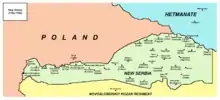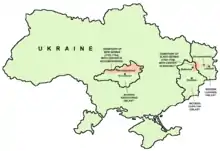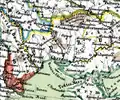New Serbia (historical province)
New Serbia, or Novoserbia (Ukrainian: Нова Сербія, Nova Serbiya, or Новосербія, Novoserbiya; Russian: Новая Сербия, Novaya Serbiya, or Новосербия, Novoserbiya; Serbian: Нова Србија / Nova Srbija, or Новосрбија / Novosrbija; Slavo-Serbian: Нова Сербія, Nova Serbiya, or Ново-Сербія, Novo-Serbiya; Romanian: Noua Serbie), was a military frontier of Imperial Russia from 1752 to 1764 subordinated directly to the Senat and Military Collegium. The founder of New Serbia was Jovan Horvat.
| New Serbia Нова Србија / Nova Srbija Нова Сербія Новая Сербия | |||||||||
|---|---|---|---|---|---|---|---|---|---|
| territory of Russian Empire | |||||||||
| 1752–1764 | |||||||||
 | |||||||||
| Capital | Novomyrhorod (Novomirgorod) | ||||||||
| History | |||||||||
• Established | 1752 | ||||||||
• Abolished | 1764 | ||||||||
| |||||||||
| Today part of | |||||||||
It was mostly located in the territory of present-day Kirovohrad Oblast of Ukraine, although some of its parts were located in the territory of present-day Cherkasy Oblast, Poltava Oblast and Dnipropetrovsk Oblast. The administrative centre of New Serbia was Novomirgorod (literally "New Mirgorod"), which is now Novomyrhorod, Ukraine.
History
The region was named after Serbs, who migrated in 1752 to the Russian Empire from the Military Frontier of the Habsburg Monarchy. Russian authorities gave these Serbian settlers a land, which thus acquired its name, New Serbia soon after the War of the Austrian Succession. As the Pannonian Frontier, New Serbia was also organized into military province located on the Russian-Polish border and on the land of Buhogard palanka, Zaporizhian Sich. The purpose of the polity was protection of southern borders of the Russian empire as well as participation in Russian military operations near that region. Commandant of New Serbia was Jovan Horvat who vouched for his subordinates the Austrian Grenz infantry.
Demographics
Before the formation of New Serbia, its territory was mostly populated by Ukrainians and included 3,710 houses of settlers from the Hetmanate, Slobozhanshchina and Zaporizhia, 643 houses of native inhabitants and 195 houses of Ukrainian settlers from Poland and Moldavia. When New Serbia was formed, the Russian senate ordered that all these settlers, except native inhabitants, must return to the places where they had previously lived.
After the formation of New Serbia, its initial new settlers were Serbs, but also many Moldavians and other Romanians (Mocani from Transylvania), Ukrainians, Bulgarians and others settled in the area.
Some of the original Ukrainian settlers who left the territory of New Serbia settled in the southern regions of modern-day Ukraine. In 1745, before the formation of New Serbia, its territory was populated by 9,660 inhabitants, while in 1754, the number of inhabitants was 3,989.
Because of the large number of Moldavian settlers, the largest ethnic group in the province in 1757 were not Serbs, but Moldavians.[1] In 1757, the population of New Serbia numbered 5,482 inhabitants, including:[2]
- 75.33% Moldavians
- 11.56% Serbs
- 13.11% others
Settlements
Settlements of New Serbia
In their new home, Serbs established new places, and consequently gave them same names such as the names of the places in their old home in the Pannonian Plain (in modern-day Serbia, Croatia, Romania and Hungary). Serbs also changed names of some older settlements, giving them Serb names. Of the 41 settlements that existed in New Serbia, 26 were founded before arrival of the Serbs.
| Older Ukrainian/Russian name (1.) | Serbian name from the middle of the 18th century | Ukrainian/Russian name from the middle of the 18th century (1.) | Newer or modern Ukrainian/Russian name (1.) |
|---|---|---|---|
| Skaleva | Semlac (2.) | Semlik | Skaleva |
| - | Novoarhangelsk / Arhangelsk | Novoarkhangelsk / Novoarkhangelysk | Novoarkhangel'sk / Novoarkhanhel's'k |
| Ganivka | Kalniblat / Kalnibolot | Kalnibolot / Kalynibolot | Kal'nibolota |
| - | Nadlac (2.) | Nadlak | Nadlak |
| Davidivka | Petrovo Ostrovo / Petro-Ostrov (2.) | Petroostriv | Petroostriv |
| Korobchino | Pečka (2.) | Bechka | Korobchine |
| Trisyaga | Novomirgorod / Novi Mirgorod | Novomirgorod | Novomyrhorod / Novomirgorod |
| Yermina Balka | Martonoš (2.) | Martonosh | Martonosha |
| Olykhovatka | Pančevo (2.) | Panchevo | Pancheve |
| Tri Bayraki | Kanjiža (2.) | Kanizh | Kanizh |
| Mogilovo | Senta (2.) | Senta | Mohyliv / Rodnykivka |
| - | Vukovar (2.) | Vukovar | Bukvarka |
| - | Feldvar / Fedvar (2.) | Fedvar | Pidlisne |
| Mala Adzhamka | Subotica (2.) | Subotitsa | Subottsi |
| Nekrasivska | Mošorin (2.) | Moshorin | Moshorine |
| - | Cibuljev / Cibulev | Tsibuliv | Tsybuleve |
| - | Dmitrovka | Dmitrivka | Dmytrivka |
| Dikivka | Sombor (2.) | Sombor | Dikivka |
| Protopopivka | Varaždin (2.) | Varazhdin | Protopopivka |
| Usivka | Bečej (2.) | Becha | Usivka / Oleksandriya |
| - | Glinsk | Glinsk | Glinsk |
| Pantaziyivka | Jenova | Yaniv | Ivanivka |
| - | Mandorlak (2.) | Mandorlak | - |
| Kosivka | Glogovac (2.) | Glogovats | Kosivka |
| Butivka | Pavliš (2.) | Pavlish | Pavlysh |
| - | Piljužnica | Pilazhnitsa | - |
| Onufriyivka | Blagovat | Blagovat | Onufriyivka |
| - | Sentomaš/Srbobran(2.) | Sentomash | - |
| - | Kovin (2.) | Kovin | - |
| - | Csanád (2.) | Chonad | - |
| - | Slankamen (2.) | Slankamin | - |
| Nesterivka | Vršac (2.) | Vershats | Vershatsi |
| Stetsivka | Šoljmoš / Šolmoš (2.) | Sholmosh | Stetsivka |
| Andrusivka | Čongrad (2.) | Chongrad | Velyka Andrusivka |
| - | Krilov | Krilov | Kryliv |
| - | Taburište / Taburino | Taburishche | Svitlovodsk |
| - | Krjukov | Kryukiv | Kryukiv (now part of Kremenchuk) |
| - | Kamjanka / Kamenka | Kamyanka | Kamyani Potoky |
| Plakhtiyivka | Zemun (2.) | Zemun | Uspenka |
| Deriyivka | Vilagoš (2.) | Vilagosh | Deriyivka |
| - | Turija (2.) (3.) | Turiya | Turiya |
Notes:
- (1.) Ukrainian and Russian names are given in Latin script transliterations.
- (2.) These names were brought by Serbs from their old homeland in southern Pannonian Plain. Places with same names are also existing (or existed) in modern-day Serbia (Vojvodina), Croatia, Romania and Hungary.
- (3.) Serb settlement of Turiya (Turija) was located in what sources are describing as a nominal Polish territory. The border between New Serbia and Poland was, however, often disputed and unstable.
Origin of settlement names
Places in New Serbia whose names can be also found in the territory of the Pannonian Plain (mostly in Vojvodina and Pomorišje) include:
- Sombor, named after Sombor in Vojvodina, Serbia
- Sentomash (Sentomaš), named after Sentomaš, modern Srbobran in Vojvodina, Serbia
- Slankamin (Slankamen), named after Slankamen in Vojvodina, Serbia
- Vershats (Vršac), named after Vršac in Vojvodina, Serbia
- Subotitsa (Subotica), named after Subotica in Vojvodina, Serbia
- Moshorin (Mošorin), named after Mošorin in Vojvodina, Serbia
- Senta, named after Senta in Vojvodina, Serbia
- Kanizh (Kanjiža), named after Kanjiža in Vojvodina, Serbia
- Martonosh (Martonoš), named after Martonoš in Vojvodina, Serbia
- Panchevo (Pančevo), named after Pančevo in Vojvodina, Serbia
- Nadlak, named after Nădlac in Romania
- Turiya (Turija), named after Turija in Vojvodina, Serbia
- Vukovar, named after Vukovar in Croatia
- Fedvar (Feldvar), named after Feldvar/Feldvarac, modern Bačko Gradište in Vojvodina, Serbia
- Chongrad (Čongrad), named after Csongrád in Hungary
- Zemun, named after Zemun, today part of Belgrade, in Serbia
- Varazhdin (Varaždin), named after Varaždin in Croatia
- Kovin, named after Kovin in Vojvodina, Serbia
- Vilagosh (Vilagoš), named after Vilagoš, modern Şiria in Romania
- Becha (Bečej), named after Bečej in Vojvodina, Serbia
- Semlik (Semlak), named after Semlak in Romania
- Petroostriv (Petrovo Ostrovo), named after Petrovo Ostrovo in Romania
- Bechka (Pečka), named after Pečka in Romania
- Mandorlak, named after Mandorlak in Romania
- Glogovats (Glogovac), named after Glogovac in Serbia
- Pavlish (Pavliš), named after Pavliš in Vojvodina, Serbia
- Chonad (Čanad), named after Cenad in Romania
- Sholmosh (Šoljmoš), named after Šoljmoš in Romania
Notes
- Olga M. Posunjko, Istorija Nove Srbije i Slavenosrbije, Novi Sad, 2002, page 36.
- Olga M. Posunjko, Istorija Nove Srbije i Slavenosrbije, Novi Sad, 2002, page 36.
References
- Mita Kostić, Nova Srbija i Slavenosrbija, Novi Sad, 2001.
- Pavel Rudjakov, Seoba Srba u Rusiju u 18. veku, Beograd, 1995.
- Olga M. Posunjko, Istorija Nove Srbije i Slavenosrbije, Novi Sad, 2002.
External links
 New Serbia location map
New Serbia location map New Serbia location map
New Serbia location map This map from 1862 mentions the Serb colonists in New Serbia
This map from 1862 mentions the Serb colonists in New Serbia.JPG.webp) This ethnic map of 1899 shows a Romanian-speaking population in the region
This ethnic map of 1899 shows a Romanian-speaking population in the region